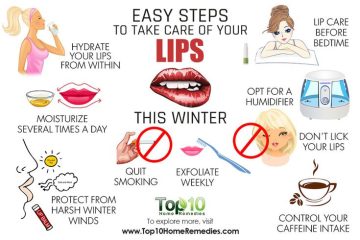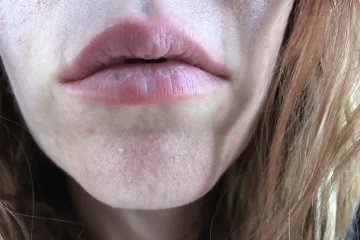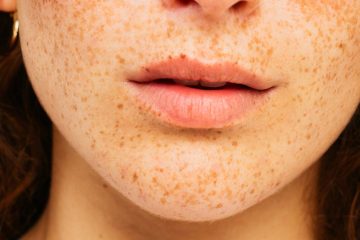New skin growth on lips typically takes about 2 to 3 weeks. This regeneration process depends on individual health and care routines.
Regeneration of the delicate skin on your lips is a fascinating and swift process, as the body works efficiently to repair and replace damaged cells. The lips are constantly exposed to environmental factors such as sun, wind, and cold, which can lead to chapping and peeling.
It’s critical to protect and nourish them to facilitate rapid healing. Lip regeneration can be slightly faster or slower depending on your overall health, hydration levels, and nutritional intake. Engaging in good lip care practices, including moisturization and protection from harsh conditions, can aid in the expedited growth of new skin. Maintaining a healthy lifestyle, with a balanced diet rich in vitamins and minerals, particularly vitamins C and E, is beneficial for skin renewal and overall lip health.
Regenerative Wonders Of The Lips
Our lips are like superhealers on our face. They fix themselves faster than any other part of our skin. Let’s dive into how and why lips have such speedy recovery times.
Rapid Healing Factors
The lips are packed with blood vessels, which means they get a lot of blood flow. This super-charged circulation delivers more nutrients and oxygen. It’s like a fast-food delivery service for cell repair. This extra help speeds up new skin growth.
- High blood supply for quick nourishment to damaged cells
- Lips have a thin outer layer, so they heal fast
- Constant renewal so they stay smooth and soft
Unique Lip Structure
The structure of our lips is not like the rest of our skin. They have a special thin layer that constantly renews itself. Because of their makeup, lips can grow new skin in just 2 days to 2 weeks, depending on the damage.
| Layer | Feature | Benefit |
|---|---|---|
| Outer layer | Thin | Fast healing |
| Inner layer | Rich in blood vessels | Faster new skin growth |
Remember, the speed of lip skin regeneration can vary. Factors could include age, hydration, and overall health.
The Skin Renewal Process
The skin on your lips is constantly renewing itself in a fascinating process. This cycle helps keep your lips smooth and healthy. Understanding the skin renewal process is key to maintaining the wellbeing of your lip skin.
Cell Lifecycle On Lips
Lips have a unique set of skin cells with a specifically tailored lifecycle. These cells are born, mature, and eventually shed to be replaced by new cells. This metamorphosis ensures your lips stay resilient against daily exposure.
Stages Of Regeneration
- New cell formation: Deep within the lip skin, new cells are born from the basal layer.
- Rapid growth: Cells quickly increase in size and begin their ascent to the surface.
- Maturation: As they move up, they mature, becoming the protective barrier of your lips.
- Exfoliation: Eventually, aged cells fall off, making way for younger cells beneath.
This cycle of renewal is rapid, with a complete turnover in about 28 days for healthy adult lips.
Additional visual representation in Table format
| Stage | Duration | Process Details |
|---|---|---|
| Birth | Day 0 | Creation of new cells. |
| Growth | Day 1-14 | Cells mature during this period. |
| Maturation | Day 15-28 | Cells become fully developed. |
| Exfoliation | Day 28+ | Old cells shed off naturally. |
Factors Impacting Lip Healing
Your lips’ ability to heal may surprise you. They can renew within 2 to 3 weeks. Yet, several factors can speed up or slow down this process. Let’s explore some key factors.
Hydration And Nutrition
Lips need water to repair themselves. Not enough water leads to dry, cracked lips. These need more time to heal. A balanced diet also plays a huge role. Nutrients like vitamin C and E help skin heal. They make new skin cells grow faster. Make sure to eat fruits and vegetables. These are good for lip health.
- Drink plenty of water
- Eat nutrient-rich foods
External Environmental Effects
Lips can heal quickly. But sun, wind, or cold can damage them. Always use lip balm with SPF. This protects your lips from the sun. In cold weather, cover your lips with a scarf. Lip balms also shield against wind.
| Element | Effect | Protection |
|---|---|---|
| Sun | UV rays can burn | Use SPF lip balm |
| Wind | Can cause chapping | Apply balm regularly |
| Cold | Makes lips crack | Cover with a scarf |
Avoid smoking and licking your lips. These habits can dry out lips. Dry lips take longer to heal.

Credit: us.gisou.com
Average Timeline For Lip Renewal
The average timeline for lip renewal can be a fascinating topic for many. Skin on the lips regenerates quicker than skin elsewhere on the body. This is because lips are a focal point for interaction and expression. They require rapid recovery from damage like dryness or minor injuries. Let’s dive into the normal recovery period and when to expect visible results.
Normal Recovery Period
Lips have a unique healing process. The outer layer of skin, the stratum corneum, is thinner on the lips. As a result, the lips can renew themselves in just 3 to 4 days. Factors such as hydration, nutrition, and overall health can affect this timeline.
- Thinner lip skin means faster cell turnover.
- Proper care can speed up recovery.
- Stay hydrated for optimal healing.
When To Expect Results
Noticeable results in lip texture and softness typically appear within a week. If your lips have been chapped or injured, it’s important to allow time for the healing process. Avoid picking or biting off flaky skin on the lips. This can lead to further irritation or even infection. Instead, use moisturizing balms and stay hydrated to support the natural renewal process.
| Days | Healing Stage |
|---|---|
| 1-2 | Initial healing; new cells form. |
| 3-4 | Dead cells shed; new skin emerges. |
| 5-7 | Full renewal; lips feel smoother. |
Patience is key in lip renewal. Even though lips heal faster compared to other skin areas, give them the time and care they need. With gentle treatment and the right products, you can expect soft, healthy lips in about a week’s time.
Differences From Other Body Parts
The lips are a focal point of expression and one of the most delicate parts of the human body. Understanding how they heal and regenerate is just as fascinating as it is essential. One key aspect of lip healing is recognizing how it differs from the rest of our body’s skin.
Lips Vs. Body Skin
Lips have unique characteristics that set them apart from the skin elsewhere on your body. First, lip skin is thinner and has fewer layers than body skin. Second, it contains fewer melanocytes, which means it has less natural protection against the sun’s UV rays. Third, lips have a higher density of nerve endings, making them more sensitive. Finally, lips lack sebaceous glands, which means they cannot produce their own moisture and are more prone to dryness and chapping.
| Lip Features | Body Skin Features |
|---|---|
| Fewer skin layers | More skin layers |
| Fewer melanocytes | More melanocytes |
| More nerve endings | Fewer nerve endings |
| No sebaceous glands | Sebaceous glands present |
Regenerative Capabilities
The lips’ regenerative process is quite rapid and efficient despite these differences. Typically, new skin on the lips can grow back in just 3 to 14 days, whereas, in other body parts, this process might take longer. This quick healing is due in part to the lips’ good blood supply, which delivers the necessary nutrients for healing. Moreover, since lips are constantly exposed to food and speech movements, their cells have evolved to turn over quickly. Although this fast regeneration keeps your lips resilient, it also requires them to be continuously cared for to prevent dryness and cracking.
- Faster healing time (3-14 days for lips)
- Good blood supply promotes nutrient delivery
- Higher cell turnover rate due to constant use
- Consistent care necessary for moisture retention
Boosting The Healing Process
Boosting the Healing Process for new skin growth on lips begins with understanding that our lips recover at their own unique pace. Yet, there are ways to support this natural process. Lips are delicate, requiring gentle care and the right products to promote fast and healthy healing.
Effective Lip Care Tips
- Stay hydrated to maintain lip moisture from the inside out.
- Avoid licking your lips; saliva dries them out more.
- Use a humidifier at night to keep the air in your room moist.
- Apply a gentle lip scrub once a week to remove dead skin cells.
- Always protect your lips with a balm containing SPF outdoors.
Products That Aid Recovery
| Product | Benefit |
|---|---|
| Lip Balm with Shea Butter | Moisturizes and nourishes. |
| Hydrating Lip Masks | Provides deep moisturizing treatment. |
| Medicated Lip Ointments | Heals and protects chapped lips. |
| Almond Oil | Natural moisture and vitamin E. |
Remember, avoid scented or flavored lip products as these can irritate healing skin.
Combining these lip care tips and products supports your lips in building new skin faster.
Signs Of Unhealthy Lip Regeneration
Your lips are a focal point of your face and health. They can regenerate skin quickly, often taking just a few days. But not always does this happen smoothly. Knowing the signs of unhealthy lip regeneration aids in taking timely action. Peeling, excessive dryness or persistent cracks may suggest something is off. Unusual color changes, swelling, or bleeding are also indicators. Now, let’s explore common concerns and know when to consult a professional.
Common Concerns
Watch for these warning signals:
- Persistent peeling beyond the usual few days
- Deep cracks or sores that do not heal
- Bleeding without any apparent cause
- Chronic dryness despite regular hydration and balm application
These can result from various factors like harsh weather, dehydration, or even lip products. Seeking solutions early prevents further complications.
When To See A Professional
It’s time to consult a professional if:
- Home remedies fail to improve your lip condition
- Symptoms persist for more than two weeks
- You notice abnormal growths or pigmentation
- Pain interferes with daily activities
Professionals can diagnose underlying issues, ranging from vitamin deficiencies to allergic reactions. Timely expert advice ensures proper treatment and healthy lips.
Protecting New Lip Skin
Protecting New Lip Skin is crucial as your lips heal and regenerate. Your lips are delicate. They are exposed to various factors that can delay healing. Proper care is essential. This care ensures soft, healthy skin renews quickly. Healthy lip habits prevent chapping and cracks.
Daily Lip Care Routines
Maintain a daily lip care routine:
- Stay hydrated: Drink plenty of water.
- Moisturize frequently: Use a nourishing lip balm.
- Gentle exfoliation: Remove dead skin cells carefully).
- Sun protection: Apply a lip balm with SPF.
- Avoid licking lips: Saliva can dry them out.
Preventive Measures
To prevent damage to new skin:
- Avoid hot, spicy foods: They can irritate new skin.
- Stop smoking: Chemicals in smoke harm skin.
- Limit alcohol: It dehydrates your body.
- Care during cold weather: Protect lips with scarves.
- Check ingredients: Use products without allergens.
Frequently Asked Questions Of How Long Does It Take For New Skin To Grow On Lips
How Fast Does Lip Skin Grow Back?
Lip skin can regenerate quickly, typically within 3-7 days. This rapid healing process helps maintain the lips’ delicate tissue.
How Can I Get New Skin On My Lips?
Exfoliate gently with a sugar scrub to remove dead skin. Keep hydrated by drinking plenty of water. Apply a nourishing lip balm regularly. Protect your lips from harsh weather using SPF lip products. Avoid biting or licking your lips to maintain new skin.
Why Is There Always Dead Skin On My Lips?
Dead skin on lips often results from dehydration, weather changes, or lip-licking habits. Consistent exfoliation and moisturizing can prevent buildup.
How Long Does It Take Skin To Grow Back After Peeling?
Skin typically regenerates after peeling within 3 to 7 days, depending on the extent of exfoliation and individual healing rates. Minor peeling usually resolves quicker than more intense cases.
Conclusion
Regenerating the delicate skin on our lips is a quick, natural process, typically spanning 2-3 weeks. For optimal healing, stay hydrated and protect your lips from harsh conditions. Nourishing balms can also promote faster renewal. Remember, individual healing rates vary, so listen to your body’s cues for the best care.
Related Post:- How Do You Know If You Have Skin Cancer on Your Lip



0 Comments